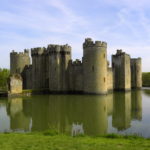The first places you visit during each trip are always special, and they seem to be even more special in England. It is due to the fact that the ferry crossing is a kind of limes between Continental Europe and Britain, where everything is slightly different. This time when opening the door of the car, I felt the strong gust of fresh wind blowing from the green meadows and I knew everything would be fine. Coming here for the long weekend in early May was the right decision. Great Dixter was a good opening of a pleasant trip.
That was what we needed to recover after a harsh long winter. With two young kids, we were often sick and were very much looking forward to the change of seasons. I was so tired, with a running nose and cough, that I had serious doubts if we should leave home. But the ferry and the hotels were already booked, the trip meticulously planned, and I wanted so much to travel and see the ‘Garden of England”- Kent, along with the neighbouring county of East Sussex. Our first stop was planned in the House and Gardens of Great Dixter.
It was the family home of Christopher Lloyd (1921-2006), gardener and gardening writer, who devoted his life to creating an experimental, exciting and constantly changing garden. With many medieval buildings, the gardens surround the house, each complementing the other. Great Dixter itself was built in the mid 15th century. Christopher Lloyd’s father Nathaniel commissioned a famous architect Sir Edwin Lutyens in 1910 to clear the house of later alterations, revealing the medieval splendour of the Great Hall, one of the largest surviving timber-framed hall in England. Lutyens also added the domestic quarters in order to accomodate an Edwardian household and a further wing, comprising a hall house of circa 1500, originally built in nearby Benenden and saved from destruction being dismantled piece by piece and re-erected at Great Dixter.

The furniture and other objects in the house date mainly from the 17th and 18th centuries and were collected by Nathaniel Lloyd. There are also many examples of needle work made mostly by his wife Daisy and their children. Completed with some contemporary furniture, they tell the fascinating history of the house.
Mr.Lloyd was passionate about passing on the knowledge to the next generations of gardeners. He set up a lecture programme on different aspects of modern gardening, with the gardens at Great Dixter as a direct reference. Workshops, lectures, study days, symposiums and school visits are organised on spot.

There is more to see and visit in Great Dixter than the house and the gardens. The medieval Great Barn is open too, alongside a Victorian oast. An oast is a building designed for drying hops as part of the brewing process. Many redundant oasts have been converted into houses. The word oast is used mainly in Kent and East Sussex.
This oast presents the history of the garden. In the White Barn you can watch displays on the house and the Lloyd family as well as a short film.
Great Dixter runs nurseries which provide direct and mail ordered sales. The plants are among the best of their kind. If you are interested, there is a detailed catalogue and expert advice is available from nursery staff.

We definitely enjoyed the refreshing stroll and the variety of plants and flowers in Great Dixter. Our next stop was the neighbouring famous Bodiam Castle, which I certainly recommend to visit when you are around. You can find out more about our trip to the “Garden of England” by clicking on the link below:









